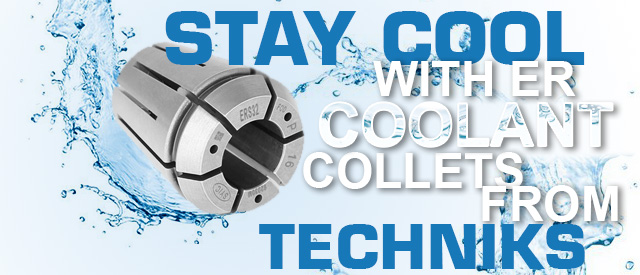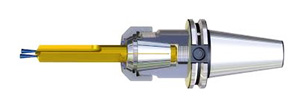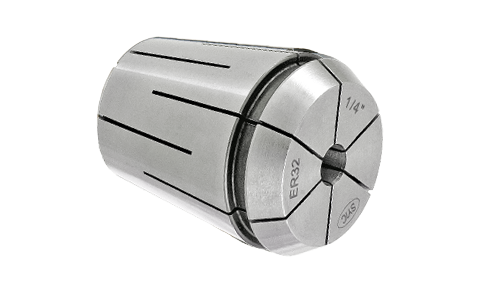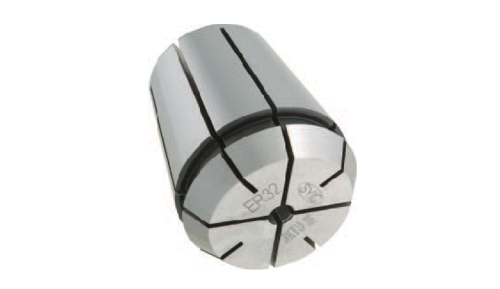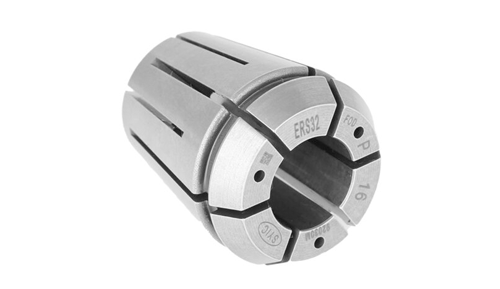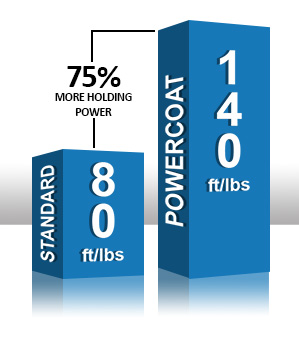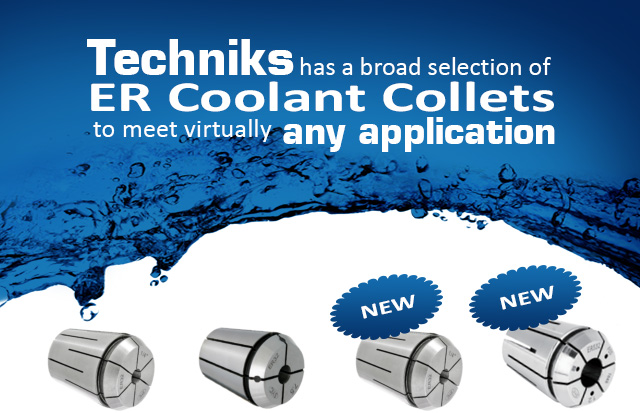Machinists often are often challenged with the need to direct coolant to the cutting area. Getting coolant to the cutting area is critical for efficient chip evacuation, adding lubricity to the cutting surface, and cooling the cutting tool to avoid unnecessary heat build-up that can lead to premature failure. Flood coolant works well for surface cutting applications like face milling, but things are a bit more tricky when machining cavities or tapping as the workpiece can obstruct flood coolant. For these reasons, Techniks has developed a broad assortment of ER coolant collets to meet virtually any cutting application.
What is a Coolant Collet?
Coolant Collets get their name because they seal the cutting tool shank to direct coolant through the cutting tool. Coolant-through tooling is growing in popularity because of its effectiveness at clearing chips from the cutting area and permitting faster feeds and speeds. Coolant-through tools, such as end mills and drills, have coolant ports built into the tool shanks directing coolant at the cutting area, regardless of the depth of the hole or cavity. For proper performance and to avoid leaking and pressure loss, coolant collets are used to seal around the cutting tool shank prohibiting coolant from leaking through the slots in the collets and forcing the coolant through the cutting tool. This creates maximum coolant pressure at the cutting area which pushes chips away from the cutting path enhancing cutting performance and improving tool life.
What Options are Available for Coolant Collets?
Techniks offers several options for coolant collets. Our Steel-Sealed Coolant Collets have become a popular choice when using high-pressure coolant. Steel-Sealed Collets have a special slotting design that prevents coolant from reaching the collet face. Since the design of the slots prevent coolant leakage, these collets can be used in high-pressure coolant applications. Techniks Steel-Sealed Coolant Collets are pressure rated to 2,000 PSI. An important consideration for choosing the correct collet bore size is that Steel-Sealed Coolant Collets are intended for on-size use, meaning they are intended for use with a specific shank diameter.
In addition to Steel-Sealed Coolant Collets, Techniks also offers plug-style coolant collets. Plug-style Coolant Collets, referred to as Coolant Collets, use rubber plugs in the slots to block coolant from leaking through the collet face. Most collet manufactures simply plug their standard collets in face slots to make coolant collets. Since standard ER collets have 16 slots (8 in the face and 8 in the back) these plugs can be rather small and can be blown out if coolant pressure exceeds their recommended value. In addition, the collapse range of standard collets, typically 0.040”, can cause plugs to be dislodged when used towards the bottom of the collapse range of the collet.
By contrast, Techniks Coolant Collets feature only 4 slots in the face. This permits larger plugs that can withstand higher coolant pressure more reliably. Techniks Coolant Collets are pressure rated to 750 PSI and have a 0.020” collapse range to avoid dislodging the plugs when clamping odd sized shanks.
What About Coolant-Through Taps?
Coolant-through taps are growing in popularity for the same reasons as coolant-through drills and end mills – they allow for superior chip evacuation. Tapping blind holes leaves very little room to evacuate chips. Therefore, coolant directed at the start of the tap help drive chips up the tap flutes and out the hole producing better thread quality and helping extend tap life.
To meet the growing need to machine with coolant-through taps, Techniks provides our ER Steel Sealed Rigid Tap Collets. These tap collets feature a unique slotting design that engages the square of the tap shank to positively lock the tap and also seal around the tap shank to direct coolant through the tap. Steel Sealed Rigid Tap Collets are available for inch and metric taps in ER16, 20, 25, 32, and 40 sizes.
What if My Tooling is Not Coolant-Through?
As good as coolant-through tooling is at helping direct coolant to the cutting area, there are instances when standard solid-shank tooling is the preferred option. For one, coolant-through tooling typically costs more than its solid-shank counterpart so changing to coolant-through tooling can be a costly endeavor. Also, very small tool shanks may not have the clearance to bore coolant ports, or a particular tool has already been spec’d into a job. For these instances Techniks offers our ER Steel Sealed Collets with CoolBLAST. CoolBLAST is a feature where coolant ports are drilled into the collet face. Coolant is sealed at the tool shank. The angled CoolBLAST ports direct the coolant to the cutting area. Steel Sealed Coolant Collets with CoolBLAST have a pressure rating of 1,400 PSI.
Don’t Forget the Collet Nut!
Coolant collets are generally more rigid and less collapsible than standard collets. Therefore, it is important to choose the right collet nut to ensure proper clamping pressure on the tool shank. Techniks PowerCOAT collet nuts feature an anti-friction coating that provides up to 75% greater clamping pressure than standard uncoated collet nuts. Uncoated collet nuts may not provide enough clamping power to ensure proper clamping pressure allowing the tool to slip while machining. Techniks PowerCOAT nuts are guaranteed to perform with our coolant collet options.
Which Coolant Collet System is Right for Your Application?
Give the experts at Techniks a call. Our knowledgeable team will help you select the coolant collet system that best meets your needs.

Greg Webb
Greg has been with Techniks Tool Group for over 23 years serving in many roles from VP of Sales to President & CEO during which he has gained a deep understanding of CNC manufacturing processes and how to optimize tooling and workholding solutions for specific applications. He has written several articles, white papers, and blogs on various tooling, deburring, and workholding-related topics. As a recognized subject matter expert on CNC tooling, Greg is often approached to provide opinions and content for technical articles.





